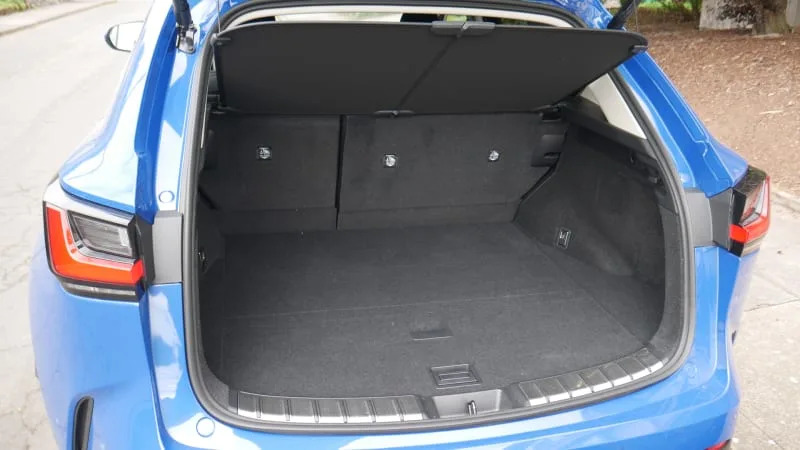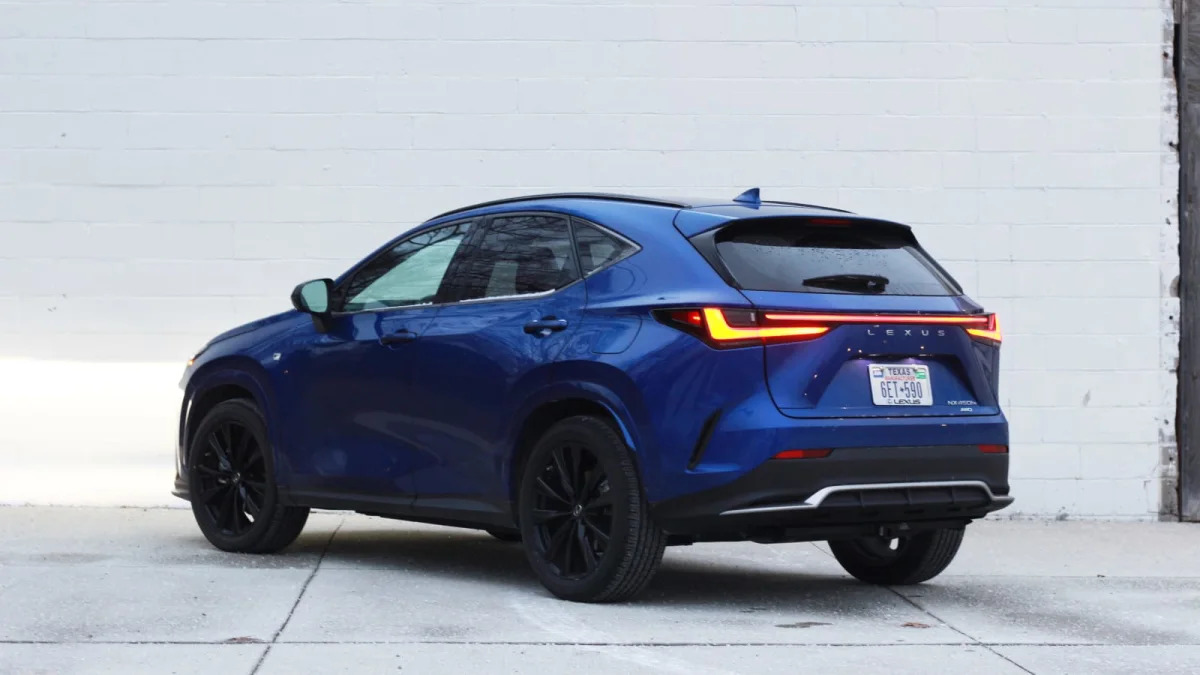Pros: Hybrid and PHEV are efficient and fun; sharp styling; lots of standard tech; top safety scores
Cons: Some of that tech is frustrating to use (especially the nonsensical HUD); less back seat space than some rivals
When it comes to the 2024 Lexus NX, it’s all about the hybrids. Available as the NX 350h regular hybrid and NX 450h+ plug-in hybrid, the fuel economy these deliver greatly exceeds that of other luxury compact SUVs. Indeed, Lexus is one of the only luxury brands to offer hybrids at all, and if you want to save gas while still enjoying the premium look, feel and features of a luxury vehicle, the NX is an obvious choice to check out.
The gas-only versions are less impressive. The base engine is the same four-cylinder that underwhelms in the Toyota RAV4, and although the NX 350’s turbocharged engine seems stout on paper, its actual performance is a letdown. Unlike the hybrids, they just don’t counter the rest of the NX’s somewhat ho-hum resume of other talents. It’s less spacious than competitors, its infotainment controls can frustrate, and it’s just not as enjoyable to drive. We also don’t think it looks particularly fresh – it’s a bit hard to tell what they changed with the full redesign two years ago.
In other words, our feelings about this compact luxury SUV are definitely mixed and whether we recommend it very much depends on what numbers and letters come after “NX.”
Interior & Technology | Passenger & Cargo Space | Performance & Fuel Economy
What it’s like to drive | Pricing & Trim Levels | Crash Ratings & Safety Features
What’s new for 2024?
The various NX model carry over unchanged for 2024.


What are the NX interior and in-car technology like?
While it may be difficult to tell the second-generation NX apart from its predecessor on the outside, the same cannot be said of the cabin. It looks just as fresh and new as it is. Importantly, the basic layout shares virtually nothing with the mechanically related Toyota RAV4 and the materials used are appropriate for a Lexus. That said, we could do without the silly electronic door handles.
Oh, and we have serious complaints about the in-car tech. The infotainment system features either a standard 9.8-inch screen with dedicated physical climate control toggles or an optional 14-inch unit that incorporates a dedicated blend of touch-sensitive and physical comfort controls blended into the screen’s lower bezel. No matter which you choose, you get a physical volume knob. This represents a vast improvement over that found in the previous NX, but lacks split-screen functionality and some other basic items, like a dedicated home screen. Going between the native Lexus functions like radio or navigation, and the standard wireless Apple CarPlay/Android Auto connectivity screens is a constant source of tap-tap-tapping frustration. We’ve also found the satellite radio interface to be poorly designed.
The infotainment screen is fitted to a panel that blends into the instrument display, which itself features a 7-inch screen. Sixty-four-color ambient lighting is available, along with wireless charging and the bizarre 10-inch head-up display (pictured below right) that’s controlled by unmarked buttons on the steering wheel (pictured below left). It’s weird and difficult to use. There’s also standard integrated music streaming services such as Apple Music, a digital phone key, user profiles for car settings, a digital rearview mirror, plus an AI assistant that responds to natural speech commands.


How big is the NX?
The Lexus NX fits into the compact luxury SUV segment. Populated by the likes of the BMW X3, Audi Q5, Acura RDX and Genesis GV70, this class seems to grow larger every year — both in terms of the size of its constituents and the sheer quantity available. The NX itself gained an additional 5 cubic feet of cargo volume with its redesign two years ago but that did virtually nothing to improve its stature in a field where it remains one of the smallest entries, comparable to the likes of the Alfa Romeo Stelvio. In fact, although the NX’s exterior dimensions significantly exceed those of subcompacts like the BMW X1, Audi Q3 and Mercedes GLA, its interior dimensions are quite similar.
That said, we found that the cargo area is more useful than its modest 22-cubic-foot measurement would suggest. In our luggage test, we managed to fit our usual six pieces of baggage with room to spare. That includes the sizable under-floor storage bin found on every NX model (in fact, cargo space is equal regardless of powertrain), which not only provides enough space for a duffel bag or groceries, but is designed to thoughtfully store the cargo cover inside the car.


What are the NX fuel economy, electric range and performance specs?
The NX comes with four available engines and is offered in both front- and all-wheel-drive configurations.
The NX 350 and its 2.4-liter turbocharged inline-four are good for 275 hp and 317 lb-ft of torque. That output exceeds the BMX X3 xDrive30i, Mercedes GLC 300 and Acura RDX, especially in terms of torque. Oddly, though, its estimated 0-60 time of 6.6 seconds is also about a half-second slower than the X3 and GLC despite its power advantage. It’s rated at 21 mpg city, 28 mpg highway and 24 mpg combined with its standard all-wheel drive.
The NX 350h hybrid produces 239 total system horsepower. This system incorporates an electronically controlled continuously variable transmission and because of its standard rear motor, includes all-wheel drive. Fuel economy checks in at 41 mpg city, 37 mpg highway and 39 mpg combined.
Ultimately, the most appealing and distinctive powertrain option is found in the NX 450h+ plug-in hybrid. Its electric motor provides the smooth, effortless punch expected of a PHEV thanks to its 304 total system horsepower. EPA estimates for 2024 were not available at the time of this writing, but it’s doubtful they’d significantly change. For 2023, the NX 450h+ could travel an EPA-estimated 37 miles on electric power alone. The miles-per-gallon-equivalent rating used to estimate a PHEV’s fuel economy came in at 84 MPG-e.

What’s the NX like to drive?
The NX has two of the most potent powertrains available in the segment (and two of the weakest, but I digress), but that doesn’t make it a performance-focused model. The NX 450h+ plug-in hybrid and NX 350 turbo are heavy and softly suspended (even in F Sport guise) resulting in an SUV that errs on the side of comfort. The steering is also devoid of feedback and putting the car in Sport mode adds too much effort, as if that’s all it takes to make a car’s steering engaging. Old trick, not an effective one. The ride is comfortable as expected, and although the F Sport’s bigger wheels do add some impact harshness, its adaptive suspension helps smooth out the rougher edges.
As for the powertrain choices, we’d stick with the hybrids. The base engine is lifted right out of the Toyota RAV4 and it feels and sounds just like it. Power is unremarkable for a luxury vehicle, and even if that’s totally OK with you, the rather course engine note we begrudgingly tolerate in the RAV4 is just uncouth in a Lexus. The Hybrid powertrain, which is far more refined than the last NX hybrid’s is a better choice, especially since it comes with a big-time fuel economy benefit (even if it too is shared with the RAV4). The NX 350’s turbo engine comes with a big-time power benefit that you’ll definitely want if that “power is unremarkable for a luxury vehicle” concern above struck a chord, but as previously stated, it hardly establishes the NX as a performance choice. The 450h+ plug-in hybrid adds a bunch of smooth, instantaneous low-end power to the mix, and is therefore the best choice for achieving an ideal balance of performance and fuel consumption.
What other Lexus NX reviews can I read?
2022 Lexus NX First Drive Review | Believe us, it really is all new
This quietly competent crossover is at its best in NX 450h+ plug-in hybrid form

2022 Lexus NX touchscreen infotainment review
New touchscreen signals the end of Remote Touch and the future of Lexus tech

Lexus NX 450h+ Road Test: A notch better than good enough
We dive deep on the 450h+ PHEV version of the Lexus NX, our favorite version of Lexus’ compact SUV.

What is the 2024 Lexus NX price?
The NX can be had in six different variants, starting with the NX 250 at $40,905. This FWD model is fairly barebones for a luxury vehicle, offering synthetic seating surfaces, eight-way power adjustable front seats, a 10-speaker audio system and wireless Android Auto and Apple CarPlay. LED headlights and DRLs are also standard, as are auto-dimming side mirrors.
Available higher-end luxury features include an excellent 17-speaker Mark Levinson audio system, integrated navigation (with the 12-inch infotainment system), a heated steering wheel and a power liftgate, among many others.
Each trim above the base comes standard with AWD and increasingly robust powertrains and interior packages. Both the turbocharged NX 350 AWD and the NX 450h+ can be optioned with an F Sport handling package that adds adaptive dampers, F Sport seats with bigger bolsters, 20-inch black-painted wheels and more. Here’s a full trim breakdown with destination charges included:
NX 250 FWD: $40,305
NX 250 AWD: $41,905
NX 350 AWD: $44,065
NX 350 AWD F Sport Handling: $49,165
NX 350h AWD: $44,205
NX 450h+ AWD: $59,405
NX 450h+ AWD F Sport Handling: $60,655


NX 250 AWD left (top mobile) and NX 350 AWD right (bottom mobile)
What are the NX safety ratings and driver assistance features?
Standard safety equipment on the 2023 NX includes adaptive cruise control with stop/start functionality; forward and rear collision detection, avoidance and automatic emergency braking; lane keeping assist and lane departure warning with steering intervention; automatic high beams and blind-spot warning. The car will also prevent you from opening the doors if it detects incoming cars and cyclists from the rear.
Available safety features include a surround-view camera system, an enhanced blind-spot warning system, front cross-traffic alerts, corner-adaptive headlights and a digital rearview mirror.
The 2023 Lexus NX has not yet been crash tested by NHTSA, but the IIHS awarded the 2022 model with its highest-possible Top Safety Pick+ honors. It scored the best-possible results in all crash tests and even got top marks in the difficult-to-pass headlight test.



